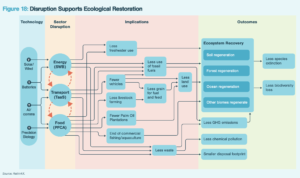
North Atlantic right whales face an increasing risk of extinction due to climate change. According to a new study by scientists at Cornell University, warming oceans have driven the critically endangered North Atlantic right whale population from its traditional and protected habitat in the Gulf of Maine into cooler waters of the Gulf of St. Lawrence, where they have been exposed to more lethal ship strikes, disastrous commercial fishing entanglements and greatly reduced calving rates. The study in the journal Oceanography, warns that if this continues the right whale populations will decline and potentially become extinct in coming decades.
The ecological crisis facing right whales is, however, part of a wider continuum of crisis that goes far beyond climate change.
For instance, when the Australian navy ship HMAS Sydney pulled into harbor in May 2021 in San Diego, California, it carried with it a gruesome cargo. Lodged under the hull were two dead fin whales, a mother and her calf, which the ship had likely struck during its voyage across the Pacific.
“Large vessels frequently strike fin whales inadvertently and unknowingly, and the dead whale remains wrapped around the bow, held in place by pressure as the boat moves forward,” reported the San Diego Tribune.
The 1800s Were Not a Great Time to Be a Whale
Indeed, for most of the 1800s, we hunted whales for their liquid oil and blubber – the thick layer of fat that could be rendered into oil for illumination. This hunting activity peaked in the middle of the 1850s, when Canadian geologist Abraham Gesner found a superior alternative. “Kerosene”, according to Gesner’s measurements, “produced a light 13 times brighter than… Whale Oils” and at the same price per gallon.
As RethinkX co-founder Tony Seba has said: “A 10x cost differential has always caused a disruption in history. Every single time.”
The discovery of kerosene, and the petroleum industry it spawned, was one of the biggest technology disruptions. The combined oil market went from 100% whale oils in 1859, in financial terms, to consistently over 80% petroleum oil just ten years later, in 1869.
But tragically, that did not stop us from killing whales. As petroleum products supplanted the whale oils for illumination, we simply shifted to hunting whales for other purposes. In the decade of the 1880s, according to Walter Tower in A History of the American Whale Fishery (1907), almost half of the revenue earned by the greatly diminished whaling industry was from whalebone, a plastic-like material used in umbrellas, corsets, and buggy whips. In the 1890s, this had grown further to nearly three-quarters.
The 1900s Were Even Worse
Petroleum-derived plastics later replaced natural materials, and the disruption of the horse by the car decreased the demand for buggy whips. Nevertheless, the whaling business made a resurgence in the 1900s as diesel-powered ships increased our capacity to hunt.
According to a 1984 article in Marine Fisheries Review called ‘The Sperm Whale: Physeter macrocephalus’ by Merrill Gosho and co-workers from the National Marine Mammal Laboratory in Seattle, Washington, the number of sperm whales hunted up to that point in the 1900s was already more than three times the number killed in the 1800s.
As the latest study in Oceanography indicates, our assault on whales has still not ended. Some species continue to be hunted by a few nations for meat, rising sea surface temperatures are driving the cetaceans further away from the equator, and increasing ocean acidity is disrupting food chains. The leading causes of death among whales now include starvation, entanglements in commercial fishing gear, and getting struck by ships.
A study earlier this year by scientists at Woods Hole, Massachusetts, the New England Aquarium, and the Oceans Initiative in Seattle, Washington, showed that 83% of identified North Atlantic right whales have been entangled one or more times in fishing gear, and 88% of necropsies conducted between 2003 and 2018 on right whales attributed death to human causes, primarily via collisions with vessels and entanglement in fishing gear. The North Atlantic right whales are now critically endangered.
But the Current Decade Could Be a Turning Point
However, technology disruptions already underway in the energy, transportation, and food sectors could have extraordinarily positive implications for whales.
The potential second and third order effects of rapidly improving technologies like solar photovoltaic (PV) panels, wind turbines, autonomous electric cars, and cellular agriculture (‘cultivated meat’) are described in detail in a new report by RethinkX called ‘Rethinking Climate Change: How Humanity Can Choose to Reduce Emissions 90% by 2035 through the Disruption of Energy, Transportation, and Food with Existing Technologies’.
Solar PV panels and wind turbines are already cost competitive with coal and natural gas in many places for electric power production. In the UK, electricity production from coal fell more than 95% between 2012 and 2020. In the US, monthly coal consumption topped about 100,000 short tons in August 2010. In the first half of 2021, this has dramatically declined, averaging less than half of that rate. Cleaner skies not only mean lower ocean acidification and lower sea surface temperatures, but also imply less shipping of bulk commodities like coal and liquified natural gas (LNG), all of which is good for whales.
Electric cars and trucks powered by lithium-ion batteries require no gasoline or diesel fuel, which together make up about half of the output from a barrel of crude oil. Because electric vehicles can drive for longer periods, their cost per mile is much cheaper, and in many cases this will make it overall cheaper to order an EV as a service compared to owning a car, meaning we will need far fewer cars.
If electric cars and trucks can drive themselves, then the switch from miles traveled by combustion vehicles to those traveled by electric vehicles could be as rapid as the switch from the horse to the car – about a decade. It would also mean we would need even fewer of them. The dramatic reduction in the number of cars and trucks on roads will mean far less demand for steel. And less demand for steel means less shipping of iron ore and coal to make steel.
All this is good news for whales. Fewer ships in the water mean fewer collisions with whales, less noise from shipping and offshore oil operations, and fewer invasive species carted around the world on ocean-going vessels. The ability to grow meats from animal cells (cellular agriculture) or to produce proteins from microorganisms (precision fermentation) could remove most of the rest of human-caused headaches from whales’ lives.
In the US, Europe and Asia, a host of startup companies have begun to produce fish and shellfish meats without raising or killing whole animals. Singapore-based Shiok Meats has produced both the world’s first lobster meat and the world’s first crab meat using cellular agriculture. In San Francisco, Wildtype Foods makes sushi-quality salmon meat that even has the alternating pink and white pattern seen in meat taken from salmon fish. Berlin-based Bluu Biosciences calls itself “the first European company to focus on producing fish from a bioreactor”. And in San Diego, BlueNalu is constructing a facility to produce multiple kinds of fish products.

The implications for life in the seas could be profound. According to ‘Rethinking Climate Change’, precision fermentation and cellular agriculture are on track to become ten times cheaper than conventional industrial food systems within about a decade, with a minimal carbon footprint in comparison. They will “wipe out the commercial fisheries and aquaculture industries that have devastated the world’s coastal and marine ecosystems”, according to RethinkX’s new report. The end of commercial fisheries would in turn mean the end of bottom trawling, which by some estimates emits as much CO2 as what is released on land through agriculture.
This would also mean less plastic in the oceans. According to The Ocean Cleanup, a Dutch nonprofit organization devoted to retrieving plastic waste from the oceans, 46% of the plastic in the Great Pacific Garbage Patch is from discarded commercial fishing gear. Making fish meat in reactors, rather than harvesting fish from the seas, could end much of the inflow of new plastic waste material.
Aquaculture is not a sustainable solution to fish meat production, as raising fish in pens still requires food, some of which comes from wild-caught fish and wild-caught animals like krill (shrimp) from waters where whales could otherwise be abundant. Much of the remainder is often soy and canola oil, which require deforestation, artificial fertilizers, and irrigation water. On top of that, commercial aquaculture emits waste, and escaped fish and diseases can affect local fish populations, all of which are to the detriment of local sea life.

But RethinkX’s work suggests that humanity is on the cusp of the most profound transformation of the system of production in human history; from an extraction-based system dependent on exploiting scarce inputs to a creation-based system that would result in dramatically lower carbon emissions, less impact on the oceans, and a greater opportunity for reforestation and maintaining wild biodiversity.
All of this could add up to an era of good living for whales the likes of which they have not seen for hundreds of years.

Can’t imagine how you have time to produce these nice “corrolaries” to your major projections, but they are valuable to all of us concerned about all corners of the planet. They must be expanding exponentially.
Your work provides the most hopeful news being produced today. Thank you all.
It is a very positive article, thank you! I hope all of this will happen as not only whales will benefit from it, but the whole marine ecosystem.
It is most refreshing to think that the light at the end of the tunnel may not be an on-coming train. Thank you!